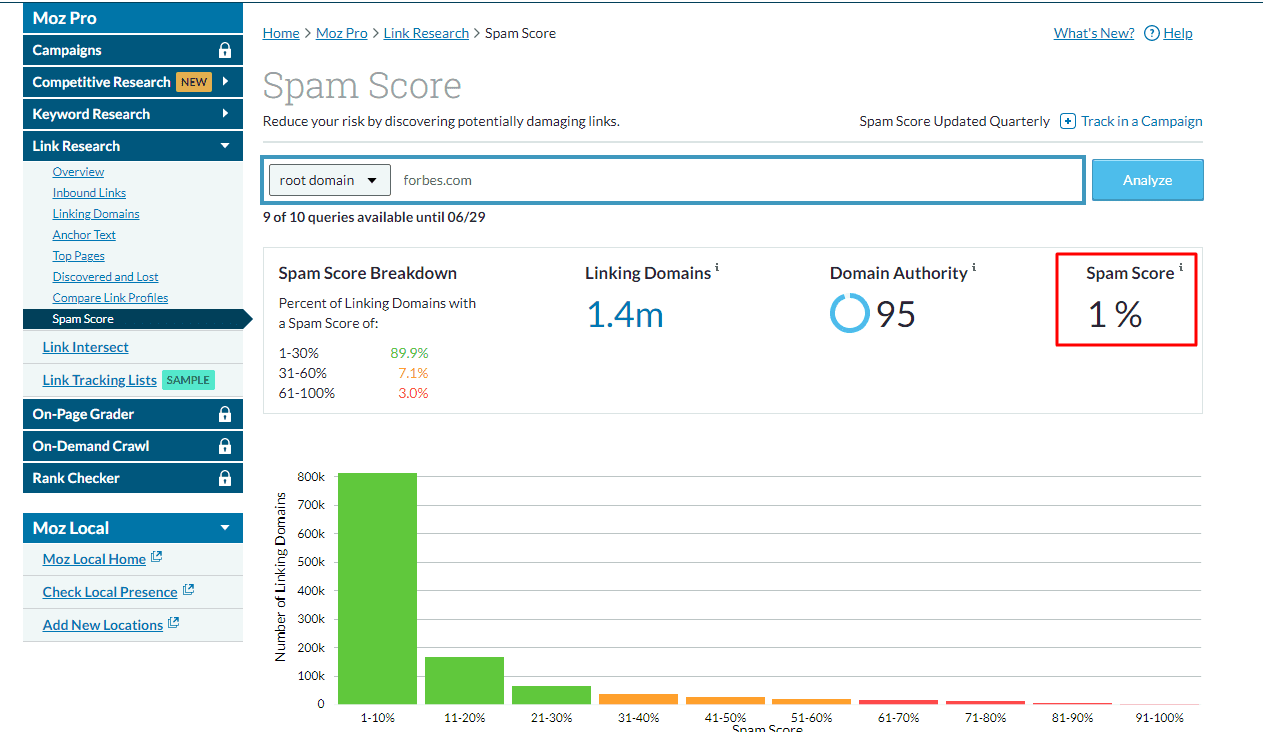
Forbes.com stats via MoZ
A website’s spam score is a general indicator of how trustworthy the website is. If a website has a higher spam score, it is more likely to get penalized by search engines like Google.
Despite having a higher spam score, some websites may not be bad or spammy ones; but merely a victim of circumstances. Therefore, you need to know the factors that can increase spam scores for your website.
In general, there are 17 factors that contribute to raising spam scores and affecting SEO. Several of them can be grouped together to resolve at once. In this context, we have separated these 17 factors into 4 groups:
- Low MozRank or MozTrust Score
- Factors concerning the links within the website
- Large site with few links
- Low link diversity in site
- Followed and no-follow links ratio
- Branded links laking proportion
- Increased number of external links
- Low number of internal links
- Using external links in navigation
- Factors concerning the website domain
- Followed and no-followed domains ratio
- TDL correlated with spam domains
- Domain length
- Domain name containing numerals
- Factors concerning the web page
- Inadequate content
- Abnormally small site mark-up
- Lacking contact information
- Inadequate number of web pages
Let’s discuss them in detail.
Low MozRank or MozTrust Score
A website with a low MozTrust score simply indicates that the backlink profile of the website is not so solid. No matter what your site is about, there are several authoritative sites in your niche. When your website fails to secure adequate backlinks from those authoritative sites, it will gain a low MozTrust score.
As a matter of fact, trustworthy websites reference authoritative websites to make their claims tangible. So, if your website lacks referencing those authoritative websites, it will look less trustworthy and shady.
So, you will need to add content that can refer to authoritative websites and can also generate backlinks from those sites to increase the MozTrust score. It can be a difficult task to perform. However, when your website acquires backlinks in a sustainable and natural way, it will efficiently increase the MozTrust score. With change in spam score, SEO practices will be affected accordingly. Check out how spam score affects SEO.
Factors Concerning the Links within the Website
In most cases, the high spam scores of a website are directly related to the links used within the website. There are 7 factors that contribute to high spam scores due to the links used:
- Large site with few links
- Low link diversity in site
- Followed and no-follow links ratio
- Branded links laking proportion
- Increased number of external links
- Low number of internal links
- Using external links in navigation
So, while you are building links, make sure to avoid these mistakes. Your links should spread evenly across the website. Ensure to get backlinks for diverse websites to make your website appear tangible and trustworthy. Maintain an even followed and no-follow link to avoid suspicion of ‘game the system.’
Your branded links may always have a bigger backlink proportion than any prominent keyword backlink. Otherwise, it may be considered suspicious behavior. Also, internal linking, which helps your viewers to navigate your website, should be adequately spread.
An increased number of external links can easily make your website look suspicious. Additionally, if you add these external links to your website’s navigation buttons, it will immensely increase the spam score. Make sure to follow this guide while you are adding links to your website.
Factors Concerning the Website Domain
Other than links, the website domain can heavily affect your spam score. Here are the factors concerning website domain contributing to spam scores:
- Followed and no-followed domains ratio
- TDL correlated with spam domains
- Domain length
- Domain name containing numerals
If your website is located under a subdomain, you should see if the top-level domain is free of spammy links or not. If the top domain is a known source of spammy links, your website may get a higher spam score, no matter the authentic practice you follow.
So, before deciding on your domain name be aware the length can affect and increase your spam score. If the name is too lengthy or contains numeric characters, your website can be considered spammy.
Factors Concerning the Website Pages
Last but not least, content or lack of content on your website pages can increase the spam score of your website. Here are the factors you should keep an eye on:
- Inadequate content
- Abnormally small site mark-up
- Lacking contact information
- Inadequate number of web pages
Make sure to give these factors a check when you are developing your web pages. Also, if you already have a high spam score, checking out your web pages can help you reduce the score and avoid getting penalized by search engines.
Bottom Line
The SEO industry is always looking out to reduce spam scores to help your website avoid getting penalized. When your website has a 0 – 4 spam score, it is considered safe, and having a rating bigger than 8 puts it in a dangerous position.
Most websites gain a higher spam score due to the links used on the website. However, other factors can also contribute to raising your spam score substantially.
Keep all these factors under careful consideration. To make your website perform better, consider hiring SEO experts, allowing their expertise to reduce spam scores.





